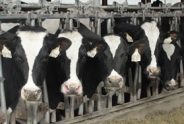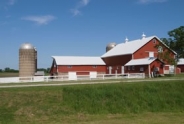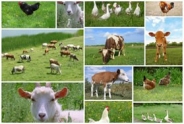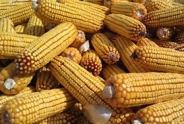Do not let cow comfort stand between you and extra milk pounds.
Camila Lage, Dairy Management Specialist
Southwest New York Dairy, Livestock and Field Crops Program
Do not let cow comfort stand between you and extra milk pounds.
By Camila Lage, Dairy Management Specialist
Once, I heard that the cow has three main jobs: get milked, eat and drink, and lie down to chew her cud, and that a farmer's job is to guarantee her the conditions to do these things well. In scientific terms, "cow comfort" is to provide cows with physical and emotional wellness, including the ability to walk and exercise freely without risk of injury, gain access to sufficient food and water to satiate their hunger and thirst, seek shelter from weather and climate extremes, and, perhaps most importantly, achieve adequate rest (Cook, 2020).
Although a simple concept, providing ideal facilities and management while balancing farm economics can prove to be a very challenging task, especially in times when margins are tight. However, overlooking "cow comfort" can cost much money in milk production, cow longevity, and operating costs, and looking at it from an investment lens rather than an expense can go a long way. In this article, we will discuss the main points of cow comfort and what the literature says about the economic benefits of improved cow comfort.
The 24-hour time budget
The daily time budget of a cow is an essential part of the cow's comfort, and the facility planning and herd management should focus on matching her natural behavior. A dairy cow at approximately 100% stocking density in free-stall housing feeds 3-5 hours daily and consumes 9-14 meals daily. In addition, they ruminate 7 to 10 hours per day and spend 30 minutes per day drinking. They should spend a maximum of 2-3 hours outside the pen for milking and other activities, as they require approximately 12 hours of lying time per day. In summary, a cow requires ~20 hours each day to herself, with no more than four hours devoted to milking or other intrusive activities.
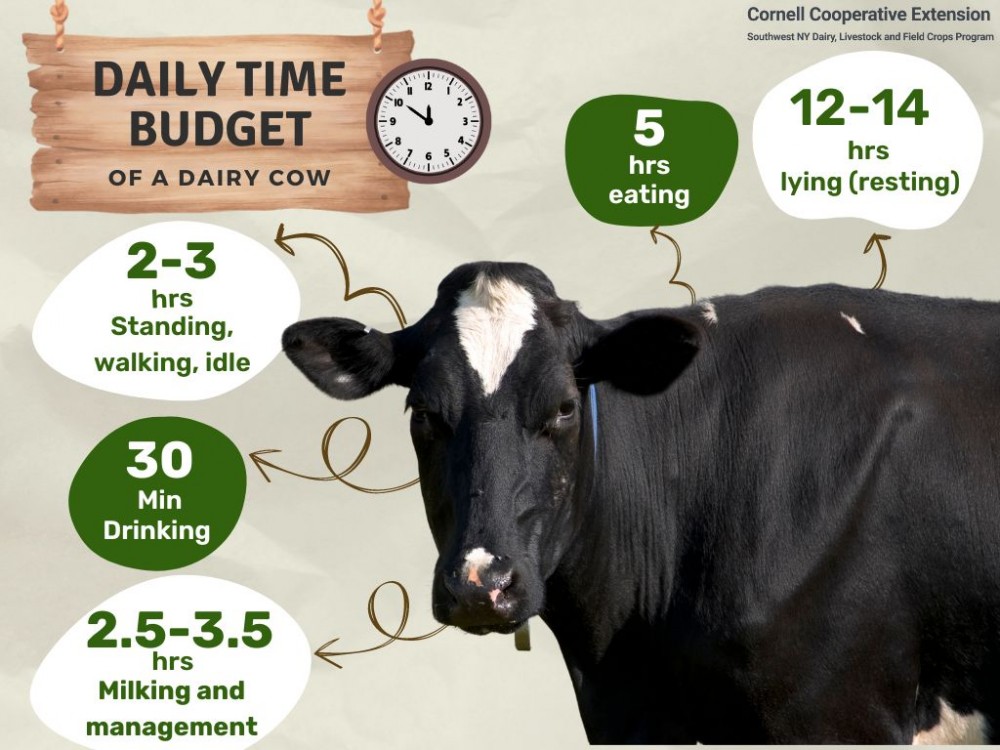
Critical Factors for Cow Comfort
Minimize time spent on holding pens, milking parlor, and headlocks: Reducing cow's "working time" is crucial for maintaining optimal feeding and resting behaviors, enhancing milk production, and reducing lameness. Exceeding 3.5 hours daily for all these activities can decrease milk production by 8 pounds/day.
Stall comfort: Providing a clean, dry, and comfortable resting place promotes higher milk production and better health in cows. As a general guideline, achieving an additional hour of resting time can increase 2 to 3.5 pounds of milk per cow. One reason is that cows prioritize resting over eating and are willing to sacrifice approximately 1 minute of eating time for every 3.5 minutes of lost rest when lying time is limited. Cows prefer a soft bed with deep, loose sand bedding, considered the gold standard. Recognizing that this is not always an option, It is important to recognize that not all beds are the same. Especially when it comes to stall bases, some can appear good initially but become quite firm over time. When considering building a new barn or retrofitting existing facilities, take the time to research the best options available. The Dairyland initiative offers valuable resources on housing for cows, serving as an excellent starting point for farmers.
Overstocking at the stall level: Overstocking (more cows than beds) reduces the cow's ability to practice natural behaviors. However, it can yield better economic returns on facility investments. Its effects on cow performance and health will vary depending on farm conditions and management practices. Generally, exceeding 120% of overstocking leads to performance declines and long-term consequences, notably health and reproduction. Overstocking conditions can disrupt cows' resting patterns, increasing the risk of mastitis and lameness.
Avoid grouping primiparous and multiparous: Mixing primiparous cows with older ones creates competition, which lowers resting activity, rumination, and milk yield for the less dominant cows. Separating them is not always possible, especially on smaller farms, but it is essential to consider stocking density if they are housed together. In such cases, ensuring comfortable stalls and effective feeding management becomes even more critical to ensure all cows receive adequate rest and feed consistently.
Feed bunk management and overstocking at the bunk level: Barn layout significantly impacts cow comfort and competition dynamics among cows. Even in barns where each cow has one stall (100% stocking density), overstocking at the feed bunk can occur. For instance, a six-row barn with a feed bunk space of approximately 20 inches per head is overstocked compared to a four-row barn with a space of about 30 inches per head. Limited space can lead to cows reducing the number of meals daily and engaging in slug feeding, which can impact rumen health. It is crucial to avoid overstocking at the feed bunk and stall space, particularly for transition groups, as close-up dry cows may struggle to compensate or recover from competition for feeding or lying space. Dr. Rick Grant from Miner Institute suggests critical elements for an ideal dining experience include adequate access to stalls, on-demand feed availability, consistent feed quality and quantity along the bunk, maintaining bunk stocking density below 100%, feeding TMR twice daily, conducting half-hour feed push-ups post-feeding, aiming for a 3% feed refusal target, and ensuring the bunk remains empty for no more than three hours per day, ideally not at all.
Environmental factors: Ensuring cows' comfort year-round is crucial on dairy farms. As cows become more productive, they become increasingly sensitive to heat stress. Therefore, implementing aggressive heat stress abatement strategies as a temperature-humidity index (THI) reaches 68 for both dry and lactating cows is necessary.
Cow handling: Gentle treatment of cows, especially in the parlor, results in a 3.5 to 13 percent greater milk yield and does not cost extra money to the farm.
Environmental enrichment and grooming: Environmental enrichment is a widely discussed concept in animal welfare. It aims to enable cows to express their natural behaviors and fulfill biological needs. Cows require exercise and grooming, which, when not fulfilled, can lead to frustration, stress, and decreased performance. An excellent example of environmental enrichment for dairy cows is the provision of cow brushes. Studies have demonstrated that access to a brush increases grooming activity by 508%, highlighting the significant role scratching plays in promoting cow well-being.
In summary, ensuring cow comfort is essential for their well-being and directly impacts milk production and farm profitability. By prioritizing optimal housing conditions and herd management, we can optimize cow health and performance while minimizing costs associated with reduced productivity and health issues. Moreover, gentle cow handling and environmental enrichment further enhance cow welfare and performance, benefiting the animals and the dairy operation.
If you would like help evaluating cow comfort or help as you consider building or retrofitting facilities, please contact Camila Lage at 607-422-6788. Cornell PRO-DAIRY also has free resources to help you design and inspect agricultural structures. If that is what you are looking for, you can also reach out to Tim Terry at txt2@cornell.edu
REFERENCES:
DeVries, T.J., Vankova, M., Veira, D.M. and Von Keyserlingk, M.A.G., 2007. Usage of mechanical brushes by lactating dairy cows. Journal of dairy science, 90(5), pp.2241-2245.
https://afs.ca.uky.edu/dairy/brushing-dairy-cow-brushes accessed on 2/8/2024
https://easyfix.com/usa/research_article/novus-economic-benefits-of-improved-cow-comfort/ accessed in 2/8/2024
https://thedairylandinitiative.vetmed.wisc.edu/home/housing-module/adult-cow-housing/ accessed on 2/8/2024
https://www.canr.msu.edu/news/stocking-density-in-a-dairy-barn-can-impact-cow-performance acessed on 2/8/2024
Rao, T.K.S., Chauhan, I.S., Fulsoundar, A.B., Gamit, V.V. and Parveen, K., 2014. Improving comfort and welfare to mitigate stress in dairy animals-a review. Wayamba Journal of Animal Science, 6, pp.1070-1084.
Upcoming Events
Boots in the Barn: Cornell Dairy Research Updates
January 13, 2026
January 20, 2026
January 27, 2026
February 3, 2026
February 10, 2026
February 17, 2026
February 24, 2026
Join us for some or all!
Advanced Hoof Health Program
January 15, 2026
Belfast, NY
Who should attend?
- Professional hoof trimmers
- Dairy farm owners or managers in charge of farm foot health
Topics include:
- How to Create a Strategic Trimming Program for your Dairy
- The Latest in Lameness Technology for the Dairy Industry
- Housing and Flooring Design: Its Role in Hoof Care
Webinar: Converting Old Dairy Barns into swine Facilities
January 21, 2026 : Webinar: Converting Old Dairy Barns into swine Facilities
Tim Terry, Farm Strategic Planning Specialist with Cornell's Pro-Dairy program will share information on what it takes to transition an old dairy barn for swine production. We plan to cover flooring, ventilation, and lighting, considerations for system workability, and more! Registration is free.
Announcements
No announcements at this time.


